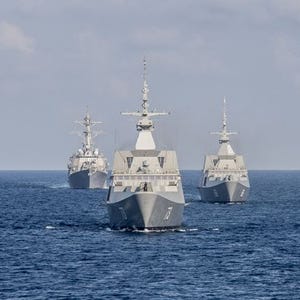
1999 AFP photo
The guided missile destroyer USS Curtis Wilbur.
WASHINGTON — The Navy challenged China and other countries’ “excessive” attempts to restrict navigation in the South China Sea on Saturday, sailing the guided missile destroyer USS Curtis Wilbur near disputed islands there, according to the Pentagon.
The “freedom of navigation operation” took the vessel within 12 miles of Triton Island, said Navy Capt. Jeff Davis, a Pentagon spokesman. The operation took place late Friday ET.
The Curtis Wilbur’s passage makes good on pledges by President Obama and Defense Secretary Ash Carter to assert legitimate claims to sail freely in international waters, Davis said. There were no Chinese ships in the area when the Curtis Wilbur sailed past.
“This operation demonstrated, as the president and secretary have stated, that we will fly, sail and operate anywhere international law allows,” Davis said. “That is true in the South China Sea, as in other places around the globe.”
China, Taiwan and Vietnam have attempted to restrict navigation around islands and other features in the area, seeking prior permission from vessels sailing near them. Their claims do not comply with international law, Davis said, and no permission was sought before the Curtis Wilbur sailed past.
Chinese government officials criticized the Navy's action, calling it a violation of law that threatened peace in the region, according to the official Xinhua news agency.
"The U.S. warship violated Chinese law and entered China's territorial sea without authorization," Foreign Ministry spokeswoman Hua Chunying said, according to Xinhua. "The Chinese side conducted surveillance and vocal warnings to the U.S. warship."
The South China Sea has become a flashpoint as China and countries in the region seek control of trade routes and mineral deposits beneath the seafloor. China has been hauling massive amounts of sand and other material to build on reefs and other features, setting up landing strips.
“This operation was about challenging excessive maritime claims that restrict the rights and freedoms of the United States and others, not about territorial claims to land features,” Davis said. “The United States takes no position on competing sovereignty claims between the parties to naturally formed land features in the South China Sea. We do take a strong position on protecting the rights, freedoms and lawful uses of the sea and airspace guaranteed to all countries. All maritime claims must comply with international law.”
Sen. John McCain, R-Ariz., who chairs the Armed Services Committee, said in a statement Saturday that he was encouraged by the Navy's action.
"This operation challenged excessive maritime claims that restrict the rights and freedoms of the United States and other nations under international law," McCain said. "I continue to hope these operations will become so routine that China and other claimants will come to accept them as normal occurrences and releasing press statements to praise them will no longer be necessary.”
In October, the Navy sailed the USS Lassen, another guided missile destroyer, near a different set of islands and reefs claimed by China. That move drew strong rebuke from China. The Chinese Foreign Ministry said the Lassen's route threatened China's sovereignty and "damaged regional peace and stability."



No comments:
Post a Comment